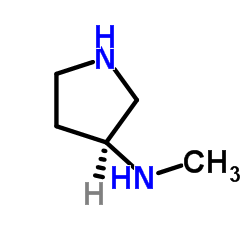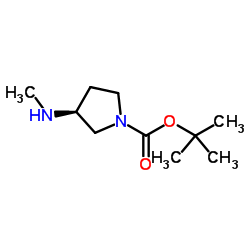139015-32-0
| 中文名 | (3S)-(+)-3-(甲氨基)吡咯烷 |
|---|---|
| 英文名 | (3S)-(-)-3-(Methylamino)pyrrolidine |
| 中文别名 | (3S)-(-)-3-(甲氨基)吡咯烷 |
| 英文别名 |
(3S)-N-Methyl-3-pyrrolidinamine
(S)-3-(methylamino)pyrrolidine (3S)-N-Methylpyrrolidin-3-amine (3S)-(-)-3-(MethylaMino)pyrrolidine MFCD00191462 3-pyrrolidinamine, N-methyl-, (3S)- (S)-N-Methylpyrrolidin-3-amine |
| 密度 | 0.9±0.1 g/cm3 |
|---|---|
| 沸点 | 141.5±8.0 °C at 760 mmHg |
| 分子式 | C5H12N2 |
| 分子量 | 100.162 |
| 闪点 | 31.1±10.2 °C |
| 精确质量 | 100.100044 |
| PSA | 24.06000 |
| LogP | -0.91 |
| 蒸汽压 | 5.8±0.3 mmHg at 25°C |
| 折射率 | 1.473 |
| 储存条件 | 室温 |
| 分子结构 | 1、 摩尔折射率:30.42 2、 摩尔体积(cm3/mol):108.5 3、 等张比容(90.2K):255.0 4、 表面张力(dyne/cm):30.5 5、 极化率(10-24cm3):12.06 |
| 计算化学 | 1.疏水参数计算参考值(XlogP):-0.4 2.氢键供体数量:2 3.氢键受体数量:2 4.可旋转化学键数量:1 5.互变异构体数量:无 6.拓扑分子极性表面积24.1 7.重原子数量:7 8.表面电荷:0 9.复杂度:54 10.同位素原子数量:0 11.确定原子立构中心数量:1 12.不确定原子立构中心数量:0 13.确定化学键立构中心数量:0 14.不确定化学键立构中心数量:0 15.共价键单元数量:1 |
| 更多 | 1. 性状:未确定 2. 密度(g/mL,20℃):0.94 3. 相对蒸汽密度(g/mL,空气=1):未确定 4. 熔点(ºC):164 5. 沸点(ºC,常压):未确定 6. 沸点(ºC,KPa):未确定 7. 折射率:-20º(C=1,EtOH) 8. 闪点(ºC):未确定 9. 比旋光度(º):未确定 10. 自燃点或引燃温度(ºC):未确定 11. 蒸气压(Pa,20ºC):未确定 12. 饱和蒸气压(KPa,20ºC):未确定 13. 燃烧热(KJ/mol):未确定 14. 临界温度(ºC):未确定 15. 临界压力(KPa):未确定 16. 油水(辛醇/水)分配系数的对数值:未确定 17. 爆炸上限(%,V/V):未确定 18. 爆炸下限(%,V/V):未确定 19. 溶解性:未确定 |
|
(3S)-(-)-3-(Methylamino)pyrrolidine
Revision number: 5
SAFETY DATA SHEET Section1. IDENTIFICATION Product name:(3S)-(-)-3-(Methylamino)pyrrolidine Revision number:5 Section2. HAZARDS IDENTIFICATION GHS classification PHYSICAL HAZARDS Category 3 Flammable liquids HEALTH HAZARDS Category 1B Skin corrosion/irritation Serious eye damage/eye irritationCategory 1 Not classified ENVIRONMENTAL HAZARDS GHS label elements, including precautionary statements Pictograms or hazard symbols Signal wordDanger Hazard statementsFlammable liquid and vapour Causes severe skin burns and eye damage Precautionary statements: [Prevention]Keep away from heat/sparks/open flames/hot surfaces. - No smoking. Keep container tightly closed. Use explosion-proof electrical/ventilating/lighting equipment. Take precautionary measures against ignition by the static discharge and the spark. Do not breathe dust/fume/gas/mist/vapours/spray. Wash hands thoroughly after handling. Wear protective gloves/eye protection/face protection. IF INHALED: Remove victim to fresh air and keep at rest in a position comfortable for [Response] breathing. IF SWALLOWED: Rinse mouth. Do NOT induce vomiting. IF IN EYES: Rinse cautiously with water for several minutes. Remove contact lenses, if present and easy to do. Continue rinsing. IF ON SKIN (or hair): Remove/Take off immediately all contaminated clothing. Rinse skin with water/shower. Wash contaminated clothing before reuse. Immediately call a POISON CENTER or doctor/physician. [Storage]Store in a well-ventilated place. Keep cool. Store locked up. [Disposal]Dispose of contents/container through a waste management company authorized by the local government. (3S)-(-)-3-(Methylamino)pyrrolidine Section3. COMPOSITION/INFORMATION ON INGREDIENTS Substance/mixture:Substance Components:(3S)-(-)-3-(Methylamino)pyrrolidine Percent:>97.0%(GC)(T) CAS Number:139015-32-0 Chemical Formula:C5H12N2 Section4. FIRST AID MEASURES Remove victim to fresh air and keep at rest in a position comfortable for breathing. Inhalation: Immediately call a POISON CENTER or doctor/physician. Skin contact:Remove/Take off immediately all contaminated clothing. Gently wash with plenty of soap and water. Immediately call a POISON CENTER or doctor/physician. Eye contact:Rinse cautiously with water for several minutes. Remove contact lenses, if present and easy to do. Continue rinsing.Immediately call a POISON CENTER or doctor/physician. Ingestion:Immediately call a POISON CENTER or doctor/physician. Rinse mouth. Do NOT induce vomiting. A rescuer should wear personal protective equipment, such as rubber gloves and air- Protection of first-aiders: tight goggles. Section5. FIRE-FIGHTING MEASURES Suitable extinguishingDry chemical, foam, carbon dioxide. media: Unsuitable extinguishing Water (It may scatter and spread fire.) media: Specific hazards arising Take care as it may decompose upon combustion or in high temperatures to from the chemical:generate poisonous fume. Precautions for firefighters: Fire-extinguishing work is done from the windward and the suitable fire-extinguishing method according to the surrounding situation is used. Uninvolved persons should evacuate to a safe place. In case of fire in the surroundings: Keep containers cool by spraying with water. Eliminate all ignition sources if safe to do so. Special protectiveWhen extinguishing fire, be sure to wear personal protective equipment. equipment for firefighters: Section6. ACCIDENTAL RELEASE MEASURES Personal precautions,Use extra personal protective equipment (self-contained breathing apparatus). Keep protective equipment and people away from and upwind of spill/leak. Ensure adequate ventilation. Entry to non- emergency procedures: involved personnel should be controlled around the leakage area by roping off, etc. Environmental precautions: Prevent product from entering drains. Methods and materials for Absorb spilled material in dry sand or inert absorbent before recovering it into an containment and cleaning airtight container. In case of large amount of spillage, contain a spill by bunding. up: Adhered or collected material should be promptly disposed of, in accordance with appropriate laws and regulations. Prevention of secondary Remove all sources of ignition. Fire-extinguishing devices should be prepared in hazards:case of a fire. Use spark-proof tools and explosion-proof equipment. Section7. HANDLING AND STORAGE Precautions for safe handling Technical measures:Handling is performed in a well ventilated place. Wear suitable protective equipment. Prevent generation of vapour or mist. Keep away from heat/sparks/open flame/hot surfaces. -No smoking. Take measures to prevent the build up of electrostatic charge. Use explosion-proof equipment. Wash hands and face thoroughly after handling. Use a closed system if possible. Use a ventilation, local exhaust if vapour or aerosol will be generated. Avoid contact with skin, eyes and clothing. Advice on safe handling: (3S)-(-)-3-(Methylamino)pyrrolidine Section7. HANDLING AND STORAGE Conditions for safe storage, including any incompatibilities Storage conditions:Keep container tightly closed. Store in a cool, dark and well-ventilated place. Store under inert gas. Protect from moisture. Store locked up. Store away from incompatible materials such as oxidizing agents. Hygroscopic Packaging material:Comply with laws. Section8. EXPOSURE CONTROLS / PERSONAL PROTECTION Engineering controls:Install a closed system or local exhaust. Also install safety shower and eye bath. Personal protective equipment Respiratory protection: Half or full facepiece respirator, self-contained breathing apparatus(SCBA), supplied air respirator, etc. Use respirators approved under appropriate government standards and follow local and national regulations. Impervious gloves. Hand protection: Eye protection:Safety goggles. A face-shield, if the situation requires. Skin and body protection: Impervious protective clothing. Protective boots, if the situation requires. Section9. PHYSICAL AND CHEMICAL PROPERTIES Physical state (20°C):Liquid Form:Clear Colorless - Pale yellow Colour: Odour:No data available pH: No data available Melting point/freezing point:No data available 164°C Boiling point/range: Flash point:No data available Flammability or explosive limits: No data available Lower: Upper:No data available 0.94 Relative density: Solubility(ies): No data available [Water] [Other solvents]No data available Section10. STABILITY AND REACTIVITY Chemical stability:Stable under proper conditions. Possibility of hazardous No special reactivity has been reported. reactions: Conditions to avoid:Spark, Open flame, Static discharge Incompatible materials: Oxidizing agents Hazardous decomposition Carbon monoxide, Carbon dioxide, Nitrogen oxides (NOx) products: Section11. TOXICOLOGICAL INFORMATION No data available Acute Toxicity: Skin corrosion/irritation: No data available No data available Serious eye damage/irritation: Germ cell mutagenicity: No data available Carcinogenicity: No data available IARC = NTP =No data available (3S)-(-)-3-(Methylamino)pyrrolidine Section11. TOXICOLOGICAL INFORMATION Reproductive toxicity:No data available Section12. ECOLOGICAL INFORMATION Ecotoxicity: Fish:No data available Crustacea:No data available Algae:No data available Persistence / degradability: No data available No data available Bioaccumulative potential(BCF): Mobility in soil Log Pow:No data available Soil adsorption (Koc):No data available Henry's LawNo data available constant(PaM3/mol): Section13. DISPOSAL CONSIDERATIONS Recycle to process, if possible. Consult your local regional authorities. You may be able to burn in a chemical incinerator equipped with an afterburner and scrubber system. Observe all federal, state and local regulations when disposing of the substance. Section14. TRANSPORT INFORMATION Hazards Class:8: Corrosive. Subsidiary risk:3: Flammable liquid. UN-No:2734 Proper shipping name:Polyamines, liquid, corrosive, flammable, n.o.s. Packing group:II Section15. REGULATORY INFORMATION Safe management ordinance of dangerous chemical product (State Council announces on January 26, 2002 and revised on February 16,2011): Safe use and production, the storage of a dangerous chemical, transport, loading and unloading were prescribed. SECTION 16 - ADDITIONAL INFORMATION N/A |
| 上游产品 0 | |
|---|---|
| 下游产品 1 | |



